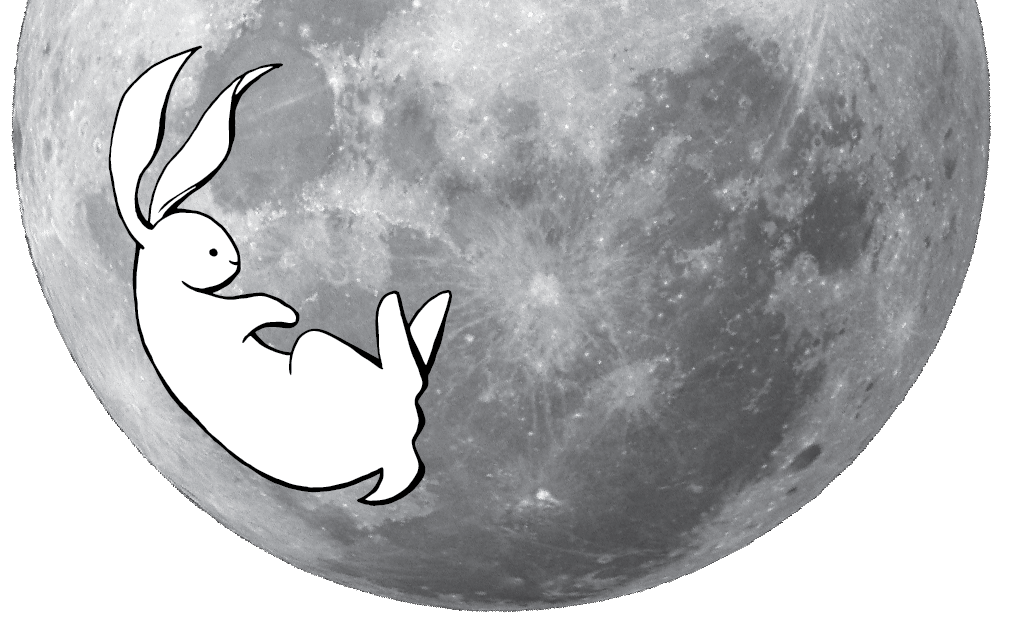

Although the Man in the Moon is a common figure to Western audiences, he is not the only moon-dweller. Alternate folklore tells of the Moon Rabbit, who lives on the moons surface. This character exists in many cultures, such as East Asian and Aztec mythology. Chinese folklore describes the Moon Rabbit using a mortar and pestle to create the elixr of life for the Moon goddess Chang'e. Japanese and Korean interpretations suggest the rabbit pounds out the ingredients for rice cake.
The Moon Rabbit mythology was inspired by paredolia, a psychological phenomenon involving a vague and random stimulus (often an image or sound) being perceived as significant. The Moon Rabbit and the Man in the Moon are some of the most famous examples of this phenomenon.


The Moon Rabbit appears in many early Chinese texts such as the Imperial Readings of the Taiping Era, and in Han Dynasty poetry as the "Jade Rabbit" or "Gold Rabbit," common phrases referencing the moon.
Many cultures incorporate a rabbit in the moon into their legends. The following are some of the more well known stories:
In the Buddhist Sasajataka (Jataka Tale 316), a monkey, an otter, a jackal, and a rabbit resolved to practice charity on the day of the full Moon (Uposatha), believing a demonstration of great virtue would earn a great reward.
When an old man begged for food, the monkey gathered fruits from the trees and the otter collected fish, while the jackal wrongfully pilfered a lizard and a pot of milk-curd. The rabbit, who knew only how to gather grass, instead offered its own body, throwing itself into a fire the man had built. The rabbit, however, was not burnt. The old man revealed himself to be Śakra and, touched by the rabbit's virtue, drew the likeness of the rabbit on the Moon for all to see. It is said the lunar image is still draped in the smoke that rose when the rabbit cast itself into the fire.
A version of this story can be found in the Japanese anthology Konjaku Monogatarishu, where the rabbit's companions are a fox and a monkey.
Similar legends occur in Mexican folklore, where people also identified the markings on the Moon as a rabbit. According to an Aztec legend, the god Quetzalcoatl, then living on Earth as a man, started on a journey and, after walking for a long time, became hungry and tired. With no food or water around, he thought he would die. Then a rabbit grazing nearby offered herself as food to save his life. Quetzalcoatl, moved by the rabbit's noble offering, elevated her to the Moon, then lowered her back to Earth and told her, "You may be just a rabbit, but everyone will remember you; there is your image in light, for all people and for all times."
Another Mesoamerican legend tells of the brave and noble sacrifice of Nanahuatzin during the creation of the fifth sun. Humble Nanahuatzin sacrificed himself in fire to become the new sun, but the wealthy god Tecciztecatl hesitated four times before he finally set himself alight to become the Moon. Due to Tecciztecatl's cowardice, the gods felt that the Moon should not be as bright as the sun, so one of the gods threw a rabbit at his face to diminish his light. It is also said that Tecciztecatl was in the form of a rabbit when he sacrificed himself to become the Moon, casting his shadow there.
A Native American (Cree) legend tells a different variation, about a young rabbit who wished to ride the Moon. Only the crane was willing to take him. The trip stretched Crane's legs as the heavy rabbit held them tightly, leaving them elongated as cranes' legs are now. When they reached the Moon, Rabbit touched Crane's head with a bleeding paw, leaving the red mark cranes wear to this day. According to the legend, on clear nights, Rabbit can still be seen riding the Moon.




Designed by Naomi Giddings
for Interaction Design Fall 2014
Washington University in St. Louis
All information from Wikipedia.org
For more information click here